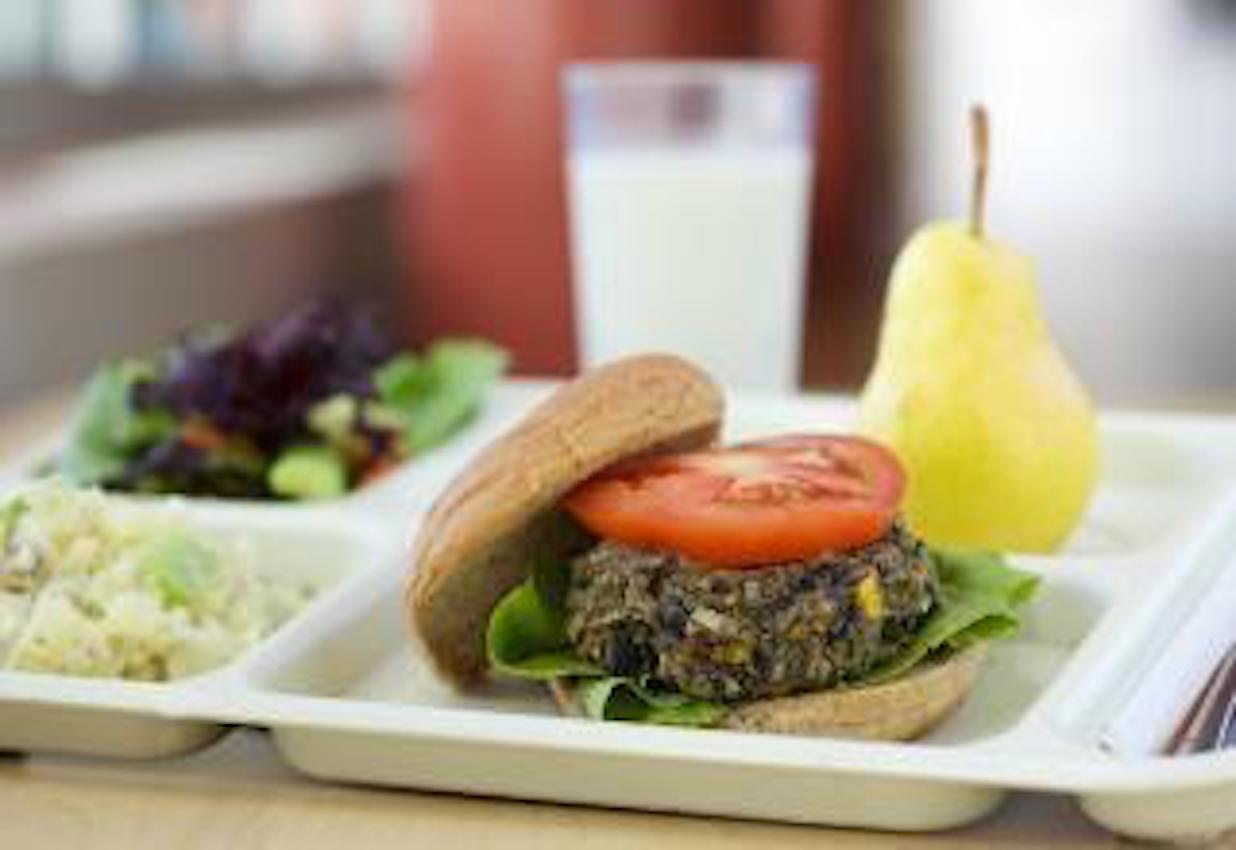Sustainable Lunchroom Case Study
Overview
BVSD has an ambitious sustainability plan, outlining a “green” mission and long-term objectives, including zero waste goals and sustainable purchasing practices. In 2009, BVSD adopted a resolution supporting environmental sustainability, jointly created with City of Boulder, University of Colorado at Boulder, and Boulder County. In 2010, the Board of Education passed a policy in support of sustainability efforts across the district. Together, the four organizations committed to prioritizing collaborative efforts in the following areas:
Creation of a workforce available for green jobs through career and technical education training, and teaching and internship opportunities;
Greenhouse gas emissions reductions and climate change adaptation planning, including unified carbon tracking and reporting;
Identification of large-scale renewable energy opportunities;
Pursuance of initiatives in furtherance of zero waste goals; and
Exploration of joint funding opportunities to further implementation of all of the above.

In order to align with this vision, the School Food Project made significant improvements to its daily operations. In 2009, BVSD moved to reusable trays, cups and silverware in all school cafeterias and began purchasing organic milk in bulk containers. The School Food Project has since introduced reusable plastic containers (RPCs) for the delivery of local produce, chicken and beef products; collecting used cooking oil to be turned into biofuel; expanded comprehensive recycling and composting programs in all school cafeterias, and more. This case study outlines best practices for several of BVSD Food Services’ sustainable kitchen and lunchroom initiatives. The intent is to provide guidance for other school food service departments looking to transform their operations into environmentally-friendly hubs.

In order to align with this vision, the School Food Project made significant improvements to its daily operations. In 2009, BVSD moved to reusable trays, cups and silverware in all school cafeterias and began purchasing organic milk in bulk containers. The School Food Project has since introduced reusable plastic containers (RPCs) for the delivery of local produce, chicken and beef products; collecting used cooking oil to be turned into biofuel; expanded comprehensive recycling and composting programs in all school cafeterias, and more. This case study outlines best practices for several of BVSD Food Services’ sustainable kitchen and lunchroom initiatives. The intent is to provide guidance for other school food service departments looking to transform their operations into environmentally-friendly hubs.
| School Meal Program | Student Demographics |
|---|---|
| 14,000 scratch cooked meals served daily | Over 31,000 students |
| 57 pre-K to 12th grade schools | 30% racial or ethnic minority |
| 3 regional production kitchens | 20% low-income |
| 1 central warehouse | 10% English Language Learners |
| 11% students with disabilities |
The Boulder Valley School District (BVSD) is a public PK-12 school district and currently has 57 pre-kindergarten through twelfth grade schools, including five charter schools, an online school, and numerous magnet schools with focal programs ranging from Montessori to Core Knowledge to Pre-Engineering. Total enrollment as of August 1, 2019, was just over 31,000. The District’s students are demographically diverse: 30% minority, 20% low-income, 10% English Language Learners, and 11% with disabilities.
BVSD Food Services, also known as the School Food Project, serves fresh and nutritious food every day, amounting to nearly 14,000 scratch-cooked meals each day. Using healthier, locally-sourced, and organic ingredients whenever possible, BVSD avoids highly processed foods, high fructose corn syrup, chemicals, dyes and food additives. All beef and chicken on the bone and nacho meat is hormone- and antibiotic-free, and the bulk milk is organic. Salad bars are offered daily at every school and are stocked with fresh, delicious, and - when possible - local farm fresh produce.
BVSD Food Services operates under a regional production model, with one centralized warehouse. The three regional production kitchens each produce meals for 14-17 schools every day, which are then transported to 54 school-based satellite kitchens for final preparation and service the following day. Additional food deliveries are made directly from the district’s central warehouse, by a local produce distributor and by a local fluid milk vendor. While these nuances create a complex school food model, these intricacies allow BVSD to implement important, sustainability-based practices and procedures throughout the operation.
Approaches to sustainable lunchroom can, and should, vary greatly between operations. The right answer or the first step should be whatever works for your school.
Starting small with a share bin or table can be the catalyst for bigger and better changes in the future. Food waste audits provide a new opportunity to engage the school community and recruit additional support for sustainability efforts. Linking lunch to academic subjects about the food system, agriculture, and the impact of food waste on the environment can help bring daily routine under a new microscope, opening students’ eyes to the need for change and the power they have to make an impact.
However, with any change implemented in a school cafeteria or kitchen, assessment, measurement, and evaluation are crucial components of the program. You can’t manage what you don’t measure. By examining your school’s current processes, you can create opportunities for sustainable processes and join the world effort of better practices for the planet and people.


Approaches to sustainable lunchroom can, and should, vary greatly between operations. The right answer or the first step should be whatever works for your school.
Starting small with a share bin or table can be the catalyst for bigger and better changes in the future. Food waste audits provide a new opportunity to engage the school community and recruit additional support for sustainability efforts. Linking lunch to academic subjects about the food system, agriculture, and the impact of food waste on the environment can help bring daily routine under a new microscope, opening students’ eyes to the need for change and the power they have to make an impact.
However, with any change implemented in a school cafeteria or kitchen, assessment, measurement, and evaluation are crucial components of the program. You can’t manage what you don’t measure. By examining your school’s current processes, you can create opportunities for sustainable processes and join the world effort of better practices for the planet and people.
Overall Waste Reduction |
1.5M
Single-serve milk cartons kept out of the waste stream each school year |
750,000
Single-use items saved in favor of resuables |
⅓
of food waste is diverted due to increased recycling and composting |
Overall Waste Reduction |
|
1.5M
Single-serve milk cartons kept out of the waste stream each school year |
|
750,000
Single-use items saved in favor of resuables |
|
⅓
of food waste is diverted due to increased recycling and composting |
Case Study - Single Download
This case study delves into the waste reduction practices in a medium-size school district, covering topics from bulk milk to reusables, sustainable procurement to reduction of food waste, and sustainable cleaners to student engagement.

Case Study
Case Study Section Pages
Food and Procurement
Increasing sustainability in food and procurement is a big undertaking. Vendor relations, tracking procurement, and understanding reusables are crucial to reducing waste in food and procurement.
Food and Procurement
Increasing sustainability in food and procurement is a big undertaking. Vendor relations, tracking procurement, and understanding reusables are crucial to reducing waste in food and procurement.
Equipment
Commercial grade, high volume kitchen equipment can be an expensive proposition, but there is payoff in the amount of energy that can be saved. Read more about equipment efficiency, sustainable cleaners and transportation in this section.
Equipment
Commercial grade, high volume kitchen equipment can be an expensive proposition, but there is payoff in the amount of energy that can be saved. Read more about equipment efficiency, sustainable cleaners and transportation in this section.
Student Engagement
Beyond providing healthy and delicious food, schools can play a crucial role in supporting sustainable food systems through student education and engagement.
Student Engagement
Beyond providing healthy and delicious food, schools can play a crucial role in supporting sustainable food systems through student education and engagement.
Certificates & Resources
School districts can demonstrate their commitment to sustainability through operation assessments.
Certificates & Resources
School districts can demonstrate their commitment to sustainability through operation assessments.








